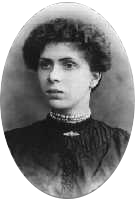The Most Interesting Library Club in America
The Communistic Library in Trenton, N. J., is located at 512½ Hudson street, in a dingy, unattractive building, but it is the home of the most interesting library in America.
The Communistic Library Club is composed of twenty members and holds meetings twice a week. At these little gatherings you will meet men from all countries, Swiss, Hungarians, Russians, Spaniards, Belgians, Italians, Austrians, Germans, French and English. The object of the club is education. Those who are interested can have books at any time without cost and more than one hundred workers take out books weekly. If they wish to co-operate with the club their names are placed on the book as monthly subscribers, and the revenue from this source covers the rent of the hall and the cost of buying books any member may suggest.
There are no officers and no votes are taken. All the discussions are the result of mutual understanding, mutual concession, free agreement. And it works. Books are never stolen, although they are taken free of cost, and for any length of time – the honor system at the highest point of development. The members do their own selecting, purchasing, arranging and borrowing. It is a case of “use your head, if you have one; if not, let me help you.”
About the walls hang pictures representing the art of a dozen schools and periods, along with excellent drawings and sketches of Francesco Ferrer and Karl Marx. A comrade who visited the library glanced at the list of books.
Here came the most staggering surprise of the visit. The range and variety, the depth and breadth of this little collection is amazing. The catalogue is written out in long hand, but in two languages. German is necessary, because the greatest works are in that tongue; 300 volumes appear in the list, divided into the following: A, romance, stories, poems and dramas; b, history and biography; c, natural history, evolution and anthropology; d, philosophy and religion; e, socialism and anarchism; f, hygiene, physiology and anatomy; g, diverse, for children; h, pamphlets and maps.
And the names that appear in the index: Tolstoi, the greatest Russian sage; Ibsen, the Norse poet-dramatist; Goethe and Schiller, twin lights of German literature; Dickens, observer and human naturalist; Darwin, the father of evolution theories; Haeckel, greatest of modem European psychologists; Emile Zola, the French novelist; Victor Hugo, Alphonso Daudet, Dostiefski [Dostoyevsky], Maxim Gorky, Heine, Kipling, Pierre, Loti and Alexander de Maupassant. All in 900 books.
Under the classification of religion appears Thomas Henry Huxley, Herbert Spencer, Tom Paine and Max Nordau stand forth from the index as favorite authors with this band of mechanics and day laborers. On the single tax there is Henry George, while Emma Goldman is on duty with her theoretical anarchy. Nietzsche, spiritual guardian of hyphenates, follows Lambroso, the criminologist, with Schoepenhauer on deck and Karl Marx at bat. Steiner, Bebel and Renan; Ferri, of the positivist school – these are a few of the writers whose products are devoured with avidity by the Communistic Library.
In the list of less than 1,000 volumes, four languages are represented. The American authors are Jack London and Mark Twain, both favorites with the foreign element because of the thrills in the former and the smiles in the latter. Among the other authors, Tolstoi, Ibsen and Goethe appear to lead. One little patron calls Peter Rosegger the Jack London of Germany, thereby displaying greater familiarity with comparative literature than many college professors.
Especially good is the collection on hygiene and anatomy. There are four volumes on the stomach, four dealing with the heart and lungs, four discussing nerves, a like number treating of the digestive tract, and, in fact, the entire human body, with medical treatment and sanitation on the one side, may be studied in this one room.
On the table a variety of newspapers and periodicals attracted the attention of the scribe. “Mother Earth” and “The Masses” were there and “Regeneration,” in Spanish. The Cleveland “Solidarity” and the London “Freedom” were side by side. “The International Socialist Review” and the “Modern School” covered up the “Critic and Guide.”
There is no propaganda to spread. A man may be an Anarchist, a Socialist, an I.W.W., stand-pat G.O.P., Democrat – he may believe in the single tax or a double standard, advocate suffrage or celibacy, follow Haywood or Gompers and no effort will ever be made to change him. He will find willing arguments but there is no effort made to disseminate doctrines of any nature. The institution is merely to provide books and a home for them, so that those who have no libraries in their homes can borrow a volume here.
A leading factor and an influential force in the education policy is Jules Scarcerieux, potter by day and teacher of French by night.
Smile at the humble institution, if you will, but do not condemn. Turn up your nose, if you must, at the cramped quarters, but admire the spirit that attracts dozens of men into the crowded rooms while the spacious marble lobbies of public libraries are deserted. Sneer at the selections in the catalogue, if it suits your fancy, but try to discuss many of the authors and see where you land. It may be a hard pill to swallow; but many of that band of seekers after truth know more about science, literature, philosophy and the world of letters in general than you do, and you can’t deny it.
The Communist Club has handled hundreds of copies of the REVIEW during the past few years.
If Socialist and union locals accomplished half the educational work of this club there would be more reason for paying dues and hall rent.
International Socialist Review, v.17, no.8, February 1917
https://www.marxists.org/history/usa/pubs/isr/v17n08-feb-1917-ISR-riaz-ocr.pdf
